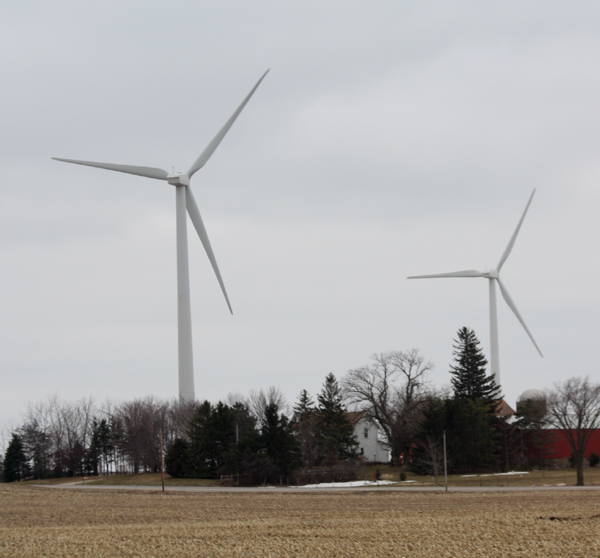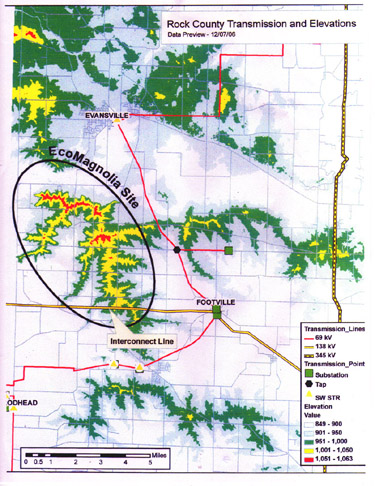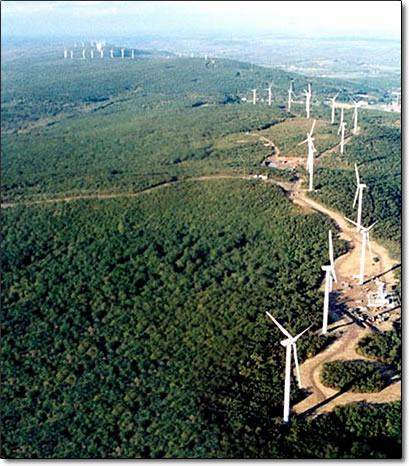Entries in Acciona (12)
1/29/10 How many is too many? Columbia County learns of yet another wind developers plans AND Glacier Hill's 18 turbine "Country Cousin" wind project has no plans to 'buy American'
 Home in a Wisconsin wind farm, Fond du Lac County. Photo by Gerry MeyerAnother county wind farm? Feasibility tests in south promising so far
Home in a Wisconsin wind farm, Fond du Lac County. Photo by Gerry MeyerAnother county wind farm? Feasibility tests in south promising so farOfficials of the Madison-based Wind Capital Group came to County Board's planning and zoning committee almost 18 months ago. They asked for, and got, a conditional use permit for two test towers, each about 197 feet high, to measure wind velocity and direction, to determine if southern Columbia County has adequate wind to sustain a 25- to 33-turbine wind farm capable of generating up to 50 megawatts of electricity.
So far, the data collected at the test towers indicates that southern Columbia County's wind seems sufficient to sustain a wind energy operation, said Tom Green of Wind Capital Group. The planned two-year testing period is scheduled to end in August.
Green said he continues to think that southern Columbia County would be a good location for what would be the company's first Wisconsin wind farm, although it has operations in other states such as Iowa.
Wind Capital Group would sell the wind farm's electricity to utilities.
But whether the wind farm goes in, he said, will depend on what the Public Service Commission of Wisconsin decides, as it sets parameters for wind farms - including setback from neighboring properties - that will apply throughout Wisconsin, and which cannot be made stricter by local authorities.
"You can't have a patchwork of rules throughout the state," Green said.
A new state law directed the PSC to set the statewide rules, which would guide municipalities, such as towns and villages, in regulating wind farms, said PSC spokeswoman Deborah Erwin.
The rules, when they are adopted, will apply to wind farms such as the one proposed by Wind Capital Group - operations that generate less than 100 megawatts.
Larger projects, such as the recently approved We Energies Glacier Hills Wind Park in the Columbia County towns of Scott and Randolph, require direct approval from the PSC. Smaller projects don't need the commission's approval, but would be subject to local regulations, provided that those regulations comply with the rules that the PSC soon will set.
But George Plenty, chairman of the town of Arlington, said officials in his town hope that an ordinance adopted last spring, requiring wind turbines to be at least 2,640 feet from buildings, still will be in place once the PSC establishes the statewide rules.
That ordinance, Plenty said, was in direct response to the proposed wind farm.
Given the density of housing in the town of Arlington, it's unlikely there would be any place in the town where a turbine could be built that would conform to a 2,640-foot setback.
"But I don't know what will happen to this ordinance when the PSC gets involved," Plenty said.
The pending PSC rules were the reason why the town of Leeds didn't adopt any ordinances regulating the placement of wind turbines, said James Foley, Leeds town chairman.
One of the Leeds town supervisors, Alan Kaltenberg, has leased some of his land for one of the test towers. Foley said Kaltenberg would abstain from voting on any matter related to the regulation of wind turbines.
For some town of Leeds residents, Foley said, a wind farm would offer an opportunity to make money from land that might not be particularly productive for farming.
"All these turbines would have to be sited on a high knoll," he said. "High knolls are usually rocky, and farmers can't farm rocks."
Plenty said he's heard of few landowners in the town of Arlington who would be willing to lease their land for a wind turbine location.
One reason for that: Town of Arlington resident Lori McIlrath, who opposes locating a wind farm in the town, has shared her concerns with area farmers.
McIlrath and her husband, Joel, have organized opposition to the project, she said, mainly because they have visited people who live near We Energies' 88-turbine Blue Sky Green Field wind farm in northeast Fond du Lac County.
McIlrath said she thinks a wind farm would cause health problems such as sleeplessness, reduce property values and create around-the-clock noise in what has been a quiet rural area.
"I ask landowners if it's truly worth whatever they'd get for their land, to do this to the community," she said.
Wisconsin utilities already are required to produce a percentage of their power from renewable resources such as wind or solar power. Those requirements might become even more stringent with a bill, backed by Gov. Jim Doyle, that's pending in the Wisconsin Legislature. One of the provisions of the Clean Energy Jobs Act is a proposal to require utilities to use renewable resources for 20 percent of their power by 2020 and 25 percent by 2025.
Wind farms are likely to become more common in Wisconsin, Green said.
That's why, he said, he has made himself available to the public, at Leeds and Arlington town meetings and at small-group sessions with southern Columbia County residents, to answer questions about the effects of a wind farm.
"It's our job," he said, "to present to the public accurate, scientific information, so they can better understand the facts about wind energy."
January 27 2010
Wisconsin regulators have approved plans to startup company E Wind to build a 30 megawatt wind farm northeaset of the State Capial of Madison at a cost of $60 million dollars. Talks are underway to buy 18 turbines fro Hyundai Heavy Industries, E-wind tells Recharge.
If the deal is finalized, it would represent the largest known US order thus far for South Korea’s Hyundai Heavy.
Wes Slaymaker, who heads a company that provides engineering services for the wind industry and is a partner in E Wind, says the next project step is to negotiate a long-term power purchase agreement with a utility.
“This is our biggest challenge because electricity prices and demand are soft,” he says in a telephone interview. “Utilities are not excited about buying more power at the moment.”
Even so, they must comply with Wisconsin’s renewable portfolio standard that requires publicly-held utilities to produce 10% of their electricity from renewable energy sources by 2015.
Governor Jim Doyle is also calling on lawmakers to pass his proposed Green Energy Jobs Act, which would update the RPS to 25% by 2025.
“I think the bill has a decent chance of getting passed,” says Slaymaker.
Once a power purchase agreement is in place, Slaymaker believes he and two local partners will obtain project financing. One of them owns part of the 1,800 acres where the turbines will be sited near the town of Randolph.
Slaymaker describes the proposed wind farm as a community project because it has local owners and operators, and most of the investment for site preparation and wind project development will stay in the region.
“This type of community wind project, while common in Minnesota, is unique to Wisconsin,” says Slaymaker.
1/24/08 How Were The Wind Rights to Magnolia Township Sold And What Does A WInd Developer Do?
 WHAT WAS SOLD AND HOW
WHAT WAS SOLD AND HOW
BPRC contacted EcoEnergy to ask what it was they sold when they sold wind development rights in our community to Acciona of Spain. We are grateful for this response, and appreciate their willingness to correspond with us, in spite of our differing views about this project. We were asked to print their response in its entirety and we are very glad to do so.
(Click here to visit EcoEnergy's Web Site)
From EcoEnergy:
“The question has come up regarding what EcoEnergy sold to Acciona and how EcoEnergy acquired this asset. In the case of the EcoEnergy arrangement with wind power leader Acciona, here's how it works. EcoEnergy does the initial project development, which includes locating good spots for turbines (based on wind maps and proprietary research related to wind patterns) and if local landowners are interested in participating, EcoEnergy then takes the project through the permitting process. At the end of the process, Acciona becomes the majority owner in the project and EcoEnergy retains an option for ownership and involvement in the ongoing operation to ensure a local, domestic presence. Both companies work together in the engineering and construction of the wind facility. In other words, EcoEnergy sold Acciona several wind project limited liability corporations. These corporations had assets, including proprietary wind data and analysis, geospatial analysis, project management, and staff time that was invested in meeting with local community members and groups. Thus, Acciona bought EcoEnergy’s development rights for the project LLC. This does not prevent another wind energy developer from working with the community, nor does it prevent community members from deciding to participate in a different project. It simply means that if EcoEnergy develops the project, Acciona will be majority owner.
It may make it clearer if we compare this arrangement with other types of long-term lease or ownership situations. In a new large building, for example, a private or public entity purchases the land for the building (roughly equivalent to the landowners in a wind facility project). In most cases, then, a developer is hired to find tenants for the proposed building (part of EcoEnergy's role, roughly equivalent to taking the project through the permitting process). A construction firm does the actual building (roughly equivalent to roles played by EcoEnergy and Acciona in this case, working together). At that point, the operation of the building is often turned over to a firm that manages it for its lifetime, including handling all its repairs and maintenance, and to whom the tenants of the building (assuming it's not a condo-type situation) pay their rent. The original owners still own the land on which the building sits, but they are not responsible for the day-to-day upkeep of the building. They receive a share of the profits from the project, but the firm managing the building for its lifetime may often be referred to as the owner and for all intents and purposes related to the running of the building, it is. It makes its money by managing the building and making sure it is well-maintained. In the case of a wind facility owned and operated by EcoEnergy and Acciona, these two companies are roughly equivalent to the firm that operates the building -- they "own" the equipment and the operation of the turbines, but the land is still owned by the original landowners, who receive annual payments for the use of that land, just as the owners of the large building -- while not involved in its day-to-day activities -- still receive payments based on its success.”
THANK YOU ECOENERGY FOR THAT RESPONSE! Please know it is appreciated.

WHAT'S A WIND
PROJECT DEVELOPER?
Need a job?
The BPRC Research Nerd has learned that Acciona of Spain has a branch in Chicago and they're looking for someone who can develop wind energy projects like the one developed and sold in our area by EcoEnergy.
(Read the ad at its original source by clicking here)
Acciona Energy North America Corporation
Title: Project Developer
Location: Chicago, IL
Sector: Alternative Energy
Occupation: Business Development
Education: Bachelors/Physical Science or Engineering
Benefits 401K
Other Features :Travel75%
Description: Acciona is a global pioneer in contributing to sustainable worldwide development through its main lines of business: development and management of infrastructure and real estate projects, provision of transport, urban and environmental services, and development and operation of renewable energies.
Acciona seeks seasoned professionals to assist in the development of utility-scale wind power projects. We have openings in San Diego, Chicago,and Toronto. This position reports to the regional head of development. This senior project management position will be responsible for all aspects of project delivery for multiple projects in specific regions throughout the United States, ensuring that their projects are completed on time and on budget. The Project Developer’s initial charter will be to focus on managing existing projects. As the U.S. and Canadian business grows, he/she will be responsible for identifying and securing new development sites, evaluating project acquisition and investment opportunities and mentoring junior staff members.
Duties/Responsibilities:
# Manage process to move projects from green field development to commercial, preconstruction stage
# Ensure that timelines and budgets for Company’s existing projects are effectively managed
# Coordinate feasibility studies and project development activities with cross functional resources, peers, and outside consultants to ensure project stays on track
# Negotiate land rights acquisition with landowners and address land use issues
# Work with Permitting Manager to define, apply for and manage complex federal, state, and local environmental, construction, and related permits and support community outreach efforts towards a variety of stakeholders
# Work with Staff Scientist to coordinate wind resource assessment activities
# Work with Power Market and Interconnection Manager to manage interconnection studies, load flow analyses and assist in PPA negotiations
# Identify and communicate to Vice President any project risks and develop mitigation strategies
# Identify and introduce new potential joint venture partners, project acquisition opportunities and green field sites
# Identify and develop relationships with stakeholders; effectively communicate with a range of personalities, including land owners, partners, government officials, technical experts, utilities, and consultants
# Manage project budget, schedule and financial modeling inputs; communicate any variance to V.P.
# Prepare and present detailed analysis; communicate status reports to V.P.
Skills Required:
# Bachelor’s degree in Physical Science or Engineering
# Previous experience in energy development required, preferably in wind energy project development, with an understanding of deregulated electric markets
# At least 5+ years in a project management position with proven track record of building, leading and managing a multi-disciplinary team, preferably in the renewable energy or power generation industry
# Excellent written and oral communications skills; the ability to develop clear and concise development plans and presentations covering project status, timeline, risk assessment, and budget needs and performance
# Ability to operate at a detailed level, to organize and multi-task, with a dedication to seeing projects through to completion
# Ability to read and interpret topographic and other land use maps, preferably with some experience with Graphic Information Systems
# Understanding of local community dynamics, with the ability to negotiate effectively with landowners, permitting authorities, utilities, and other stakeholders
# Understanding of cost accounting, budgeting, and contract implementation
# Works well in a team environment and must be able to collaborate
# Business and utility industry experience preferred
# Willingness to travel regionally (generally 20%, but at times up to 50%)